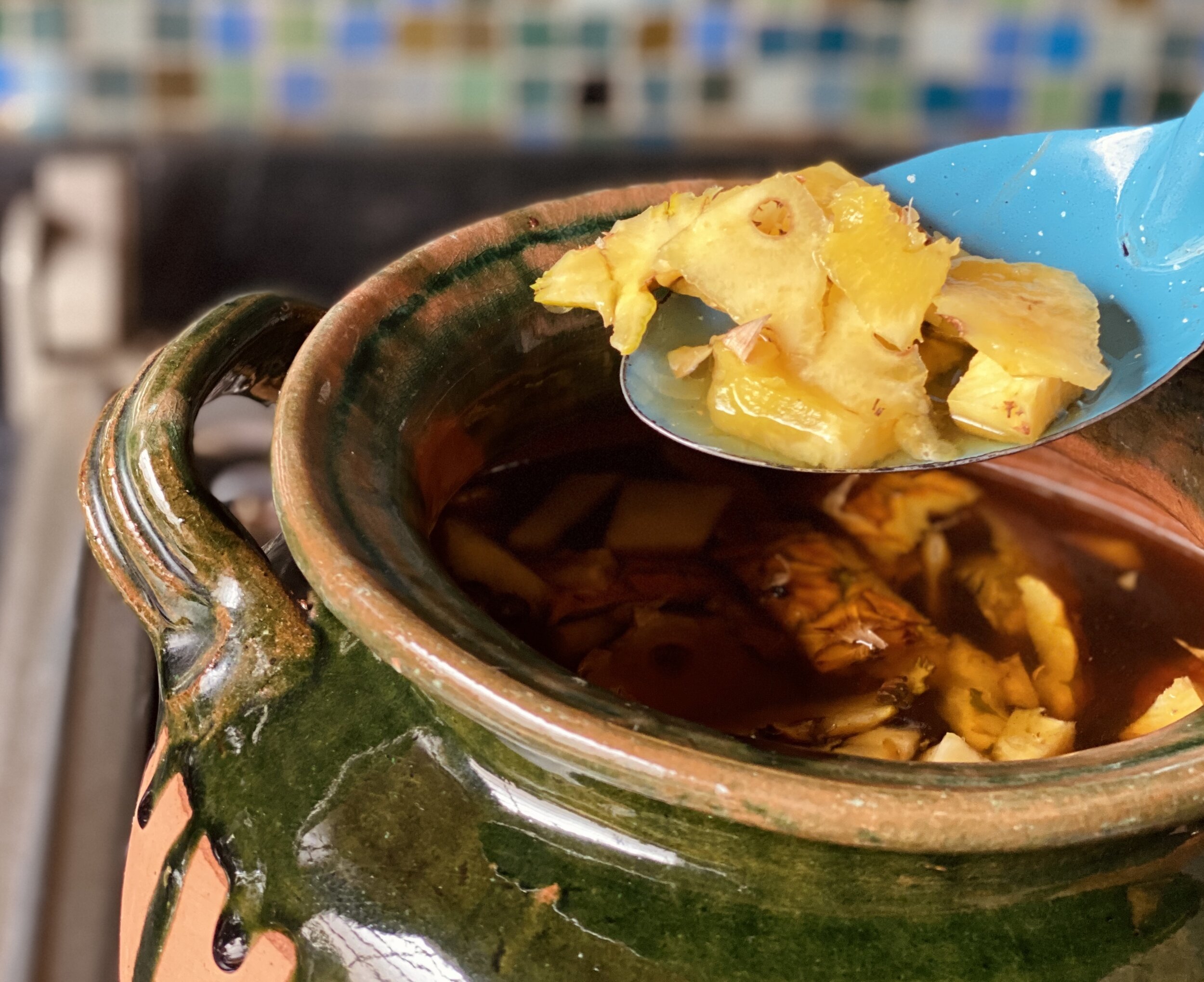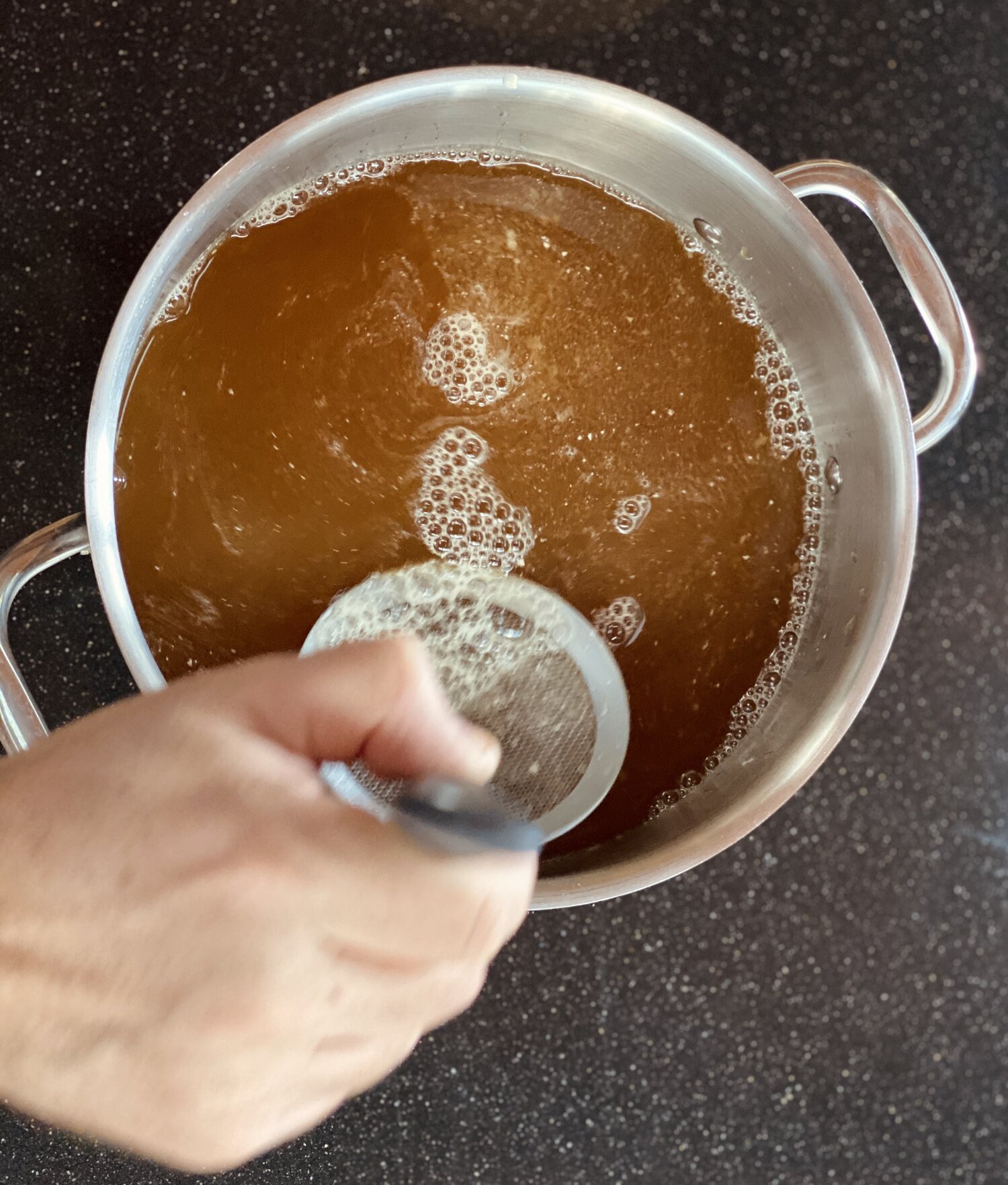Making Tepache From Scratch
Torn between my own memories and the recipes I found out there.
Written by Jorge Fitz | 6.5 min read
Mexican fermented drinks tejuino and pulque have a cousin that fewer people are discussing: tepache, which I find the most refreshing and delicious. I wanted to recreate the tepache of my childhood, fruity, slightly fizzy and with a nice spicy roundness.
There seems to be a big buzz around all things fermented. Personally, I have always liked the flavors that fermentation brings to things, although I used to strongly dislike (as a kid) thinking of how those flavors came to be. Foods like pickled chiles in their infinite presentations, which in México we refer to as encurtidos would be a feast to help to make—and eat—in my Abuela Tita’s kitchen. Back then, I wouldn’t go for the chiles themselves, but for all the other veggies that were part of the preparation. Growing up, fruit vinegar was also a thing, before everybody decided to deem it just too complicated to do at home… apparently at the same time.
Pulque, Tejuino and other cousins of Kombucha
Drinks like pulque, fermented agave sap, in central Mexico and tejuino, a sweet & savory fermented corn masa drink in Mexico’s Occidente have been garnering attention from international crowds in recent years. But those two have a cousin that fewer people are discussing: tepache, which I find the most refreshing and delicious.
You may be able to find tepache all around Mexico, although sadly nowadays a tepachería seems an esoteric find even for Mexico City locals.
I imagine the tepache we make today has very little to do with what our pre-Columbian ancestors made; many of the ingredients came to the Americas later, as part of the Columbian Exchange…
The ancestral recipe
The name Tepache suggests a pre-Columbian origin, although I imagine the drink would have been a completely different thing before the Spaniards came to Mexico since yes, the pineapple is from the Americas, as well as the allspice, but the other ingredients like cinnamon from Sri Lanka or the cloves from Indonesia, let alone sugar cane, originally from New Guinea, weren’t. Actually, the word Tepatli means “drink made with mashed corn” in Náhuatl, the language of the Aztecs, so yes, the recipe has completely evolved since those days to the point that it no longer involves corn.
Looking to make tepache to quench our thirst in the warm days of the Mexican spring, I found myself looking for a recipe in old recipe books and on the internet. The old books were a bit obscure and offered only two lines’ advice on a process that is not complicated, but surely requires more than that. The internet came back with interesting recipes, recommendations and myriad variations, like adding beer to it when it was already fermented or even getting it started with diluted Coca-Cola. Erm… no thanks.
I have a very clear idea of the scent and flavors of that tepache that I fell in love with growing up in the State of Morelos, just south of Mexico City.
So I decided to cut my teeth on tepache with my own alterations to the best-looking recipe, trying to pay homage to Tepache de Morelos, the one that I fell in love with as a kid. I’m very happy to report that the result was a fragrant, slightly fizzy and very refreshing drink, with the right amount of spice, if I say so myself. You be the judge! Here goes:
Casa Jacaranda Tepache
Yields 4 liters, roughly 4 quarts
Ingredients
1 medium pineapple
1 gallon of filtered water
8.8 oz (140 g) piloncillo (panela)
2 sticks cinnamon
1 large pinch allspice corns
1 pinch clove
1 pinch sea salt
See the note on pineapple sourcing below, as you may require some baker’s yeast
Utensils
A pot that will hold 5 quarts of liquid. You can use this pot for the fermenting or you could transfer it to a large enough jar or clay pot
A clean kitchen towel or cheesecloth that will cover the pot
String to tie the cloth to the pot
A note on the pineapple! May 2024
It’s been a couple of years since I worked on this recipe to make the best tepache –according to my childhood recollections–. I’ve gotten many messages on how it really makes delicious, slightly spicy and refreshing tepache (thank you so much for sharing!). However, a question was raised on two occasions as to why the fermentation didn’t happen. First off, we put it down to the water with the disolved piloncillo not being allowed to cool down and added to the pineapple rinds too hot. But then a second test was made with lukewarm water –what the recipe originally calls for– with the same result.
Do this if your fermentation is too slow… or if it doesn’t even happen.
My friends Kelsey Ramage and Iain Griffiths (two world-class bartenders) were making tepache in London a while back and were never able to ferment it with the pineapple’s natural yeasts: they explained that some fruit is processed before it’s shipped from “remote locations” to prevent the spread of agro diseases… the fragile yeast suffers from this procedure to the point that it all but vanishes from the pineapple peel! They fixed this by mixing 1 gram of baker’s yeast per liter of liquid in their preparation. By their ratio, if you have a gallon, you’ll need 4 grams (0.14 oz) to get a beautiful fermentation going. In my experience, you can also go around this issue –which, as explained above, has only been reported to me twice– by sourcing the most natural pineapple available. By that, I mean buying it from the smaller mom and pop bodegas (fruit and grocery stores), or perhaps getting an organic one. Happy tepache making! Please share your results.
Tepache procedure
Remove the pineapple’s head and put it in the compost bin or in a dish with water to allow it to grow roots.
Wash the pineapple thoroughly using a produce brush.
Peel it and remove all the brown spots from the flesh, so that your pineapple ends up smooth on the sides. We will not be using the actual fruit, so put it in the fridge
In a pot large enough to hold over one gallon of liquid, heat approximately 1 qt of water, add the piloncillo and spices and allow it to boil. When it does, lower the heat and stir frequently until the piloncillo is dissolved. Once it is, turn the heat off and allow it to cool down until it’s lukewarm.
Meanwhile, chop the pineapple rinds roughly into pieces that are more or less the same size.
Add the pineapple rind to the piloncillo water, and stir to integrate. If you’re fermenting the tepache in that pot, proceed to step 8. If you’re using the baker’s yeast, now’s the time when it would go into the preparation.
Transfer the preparation to the container that will keep it for the next few days.
Cover its mouth with a piece of cloth or cheesecloth that will allow it to breathe but will keep alien objects (or insects) away. Tie a string tightly around the mouth of the container to make sure that the cloth will stay in place.
Place the whole thing in a warm corner of your kitchen, away from drafts (i.e. open windows, AC units or vents).
And now it’s time to wait for the natural yeast present in the pineapple rind to work and ferment! It’ll take roughly three days for it to be ready (read “The fermentation process” below). Smile at it every day. Tepache needs love, too!
When ready, take out all the bubbles and rinds from the surface. Then, using a pasta strainer, strain the whole batch into a clean container. Take out any foam left with a skimmer. You may choose to strain it again with a fine-mesh strainer.
Your tepache is ready! Put it in the fridge to cool and always serve it over ice. I imagine you will drink it in a couple of days, but if you’re thinking of freezing a part of it, go ahead.
The fermentation process
Spring is warm in Mexico City, so by the end of day one you could smell the fermentation already starting to happen. On day two, we uncovered the pot to see what it looked like and it already had a layer of white bubbles/ooze (see pics above). When you see that, don’t mistake it for mold. Mold looks dry, powdery and fuzzy and always sits on the surface. When you touch it, mold will rub off on your finger. If you find mold on your batch, discard it. Looking into mold a bit more, we found that apparently keeping your preparation at 80-90º F (26-30º C) or warmer eliminates 96% of the chances of mold. Adding 3 tbsp of cheap white vinegar may also help to avoid mold.
By day three, our kitchen had a clear smell of fermented fruit. Sure, it was quite funky, but I would also call it fragrant and spicy: beautiful.
On day three, we uncovered the pot to find quite a bit of bacterial activity going on. Don’t take me wrong, while it didn’t look like it was boiling or bubbling, you could definitely see a clear difference from the day before. Then, we continued with the process described above in the recipe. However, if your local weather isn’t warm enough, your tepache may take up to a week to reach that level of fermentation.


















